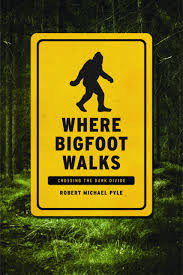Robert Michael Pyle
Counterpoint

|
…hundreds of readers have written or cornered me and put it to me: “So—do you believe, or not?” I never give them satisfaction, because the fact is, I still don’t know. The best of the evidence is not easily dismissed and is sometimes compelling. But proof—in the form of big artifacts like bone or tiny molecules of DNA—continues to be maddeningly elusive. from Where Bigfoot Walks |
BIGFOOT FOUND! (No, just kidding.)
There were many times when climbing in the Goat Rocks wilderness that I wished I had someone like Bob Pyle along with me: a naturalist who could identify that pretty little alpine flower or that high-altitude butterfly, a poet who could put into words the beauty and wonder I was experiencing, and a storyteller who, as we sat around the (small, environment-friendly) campfire, would enthrall me with his tales of mountain lore, none more so than about Sasquatch.
In the 1990s, Pyle set off to explore “all things Bigfootish,” viewing the evidence, talking with the investigators, from responsible scientists to kooks, even diving into the tabloids (“I Am the Mother of a Bigfoot Baby.”)
The resulting book, Where Bigfoot Walks: Crossing the Dark Divide, was published in 1995, and has been recently re-issued in an expanded version with the latest research.
What he reports is tantalizing. The late Grover Krantz, professor of anthropology at Washington State University and among the first academics to give the search scientific legitimacy, analyzed many tracks, pronouncing some to be genuine. He proposed that Bigfoot could be a descendant of Gigantopithecus, a huge primate in the Pliocene and Pleistocene eras, that has managed to survive here and as the Yeti in the Himalayas. Other scientists have suggested these creatures might be surviving Neanderthals.
Pyle also explored the numerous Indian traditions about the large hairy animals that pre-date the arrival of white men (Sasquatch comes from the Salish saskehavas,) as well as the accounts of early explorers and missionaries. In 1811, the Yukon explorer David Thompson recorded finding tracks of a biped measuring 14 by 8 inches in the snow.
He reviewed later accounts. The first recorded report of a man-like giant in California was in 1886, in the vicinity of Crescent City. There was the 1924 account of miners who were attacked by “giant hairy apes” in what came to be called Ape Canyon (In fairness to Sasquatch, the miners had shot one of their band.)
Then there is the iconic 1967 Patterson-Gimlin film of a female creature at Bluff Creek in northern California, which Pyle concludes is “not definite proof but also not dismissable.” Disney studios claimed no one could have “manufactured” the film except them—and they had not.
The descriptions have been consistent from the earliest accounts: of a 7-foot or taller hairy creature with human-like face, big feet 14-18 inches long, and exuding an intolerable smell—although to be fair, most backpackers who have been on the trail for three or more days usually exude an intolerable smell.
In the updated version, Pyle presents more recent evidence that is compelling and not easily dismissed, including tracks that he has found on three occasions. Yet in spite of the many efforts, the actual creature remains “maddeningly elusive.” (The North American Wildlife Research organization constructed a Bigfoot trap. Over six years, they managed to catch one bear and one hippie.)
No doubt, if I were to meet the creature in the Dark Divide, Bob Pyle is the fellow I would want with me. (“Relax, it may not be real.”)
This review first appeared in The Columbia River Reader (October 15-November 25, 2017.) Reprinted with permission.



